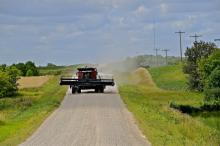Information Possibly Outdated
The information presented on this page was originally released on August 26, 2020. It may not be outdated, but please search our site for more current information. If you plan to quote or reference this information in a publication, please check with the Extension specialist or author before proceeding.
Fall driving requires extra caution for farm vehicles
STARKVILLE, Miss. -- Fall brings a surge in the number of farm machines travelling on the state’s roads, and drivers everywhere need to be cautious when near them.
State laws allow farm vehicles on roadways but place limits on driving them on roadways during daytime hours. This authorization is necessary to allow farm vehicles to reach all parts of the often very large farms to which they belong.
Drivers must remember they share the road with these large, often unwieldy vehicles. Most importantly, drivers must stay alert and allow time to act safely when approaching one.
Alex Deason, an agent in Sunflower County with the Mississippi State University Extension Service, said spring and fall are busy times for farm equipment, but fall tends to be busier.
“Most of the slow-moving equipment is moved first thing in the morning to allow for a day full of operations, but once a farm or tract of land has been covered, farm managers may choose to move to another location midday,” Deason said.
While it is legal and necessary for farm vehicles to use roads, the large machines can block a driver’s view of traffic. Deason said it is even harder for the operator to keep attention on the road, look for obstacles in front and keep an eye on what is behind.
“Operators are required to always use warning lights and display slow-moving vehicle placards,” Deason said. “Avoid peak traffic times such as when people are going to or from work and school or lunch, and when able, the farm vehicle should slow down and move to the shoulder to allow traffic to pass safely.”
Meeting a farm vehicle head-on is easiest because there is generally time to slow down and for both vehicles to move close to the shoulder. Deason said most fatalities occur when a distracted driver collides with slow-moving machinery from behind.
“Never overtake farm equipment at highway speeds,” he said. “Always slow down to safer speeds. Don’t assume when passing a piece of equipment that it is alone. There could easily be a pickup, combine and two tractors with grain carts in succession moving to the next field.”
Fall also sees more trailers towed behind vehicles on the roads, including hunters towing off-road vehicles and farmers moving equipment.
Leslie Woolington, Extension risk management and loss control agent, said trailers present a unique danger when they are used improperly or not well maintained.
“If you pull a trailer, it’s your responsibility to ensure its safety for you and others on the road,” Woolington said. “Trailers have the potential of becoming unguided missiles if they are not properly hooked up or cared for.”
She said those planning to tow a trailer should inspect the tow vehicle for loose bolts, deformation and damaged. Also ensure the ball on the tow vehicle matches the coupler size on the trailer. Use a trailer coupler connection with a pin to ensure it cannot disengage from the ball. If there is a trailer coupler with a tension bolt, ensure it is properly adjusted.
“Connect the trailer electrical plug and breakaway cable to the tow vehicle and ensure all are working correctly,” Woolington said. “For a bumper-pull trailer, cross the safety chains underneath the coupler with enough slack to permit turning, but not dragging the ground. This will help to hold the tongue up if the trailer comes loose.”
Once the trailer is safe and attached correctly, make sure the load is ready for transport, she said. Tie down or tarp the load, and make sure the trailer deck is free of any loose tools or debris mud.
“During long hauls, stop periodically to do a quick walkaround ensuring trailer is still in good shape and the load is secured,” she said.





